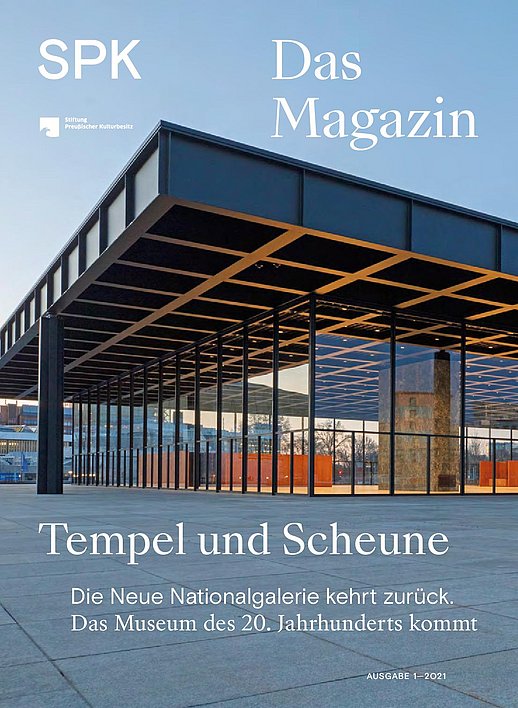Bereichsnavigation
SPK Magazine 1/2021: Temple and Barn
The Kulturforum: a place where architecture, art, music, science, and literature come together. The new issue takes you on a tour of this unique cultural landscape, past the newly renovated Neue Nationalgalerie and the busy building site where the Museum des 20. Jahrhunderts is taking shape.

Art historian Christian Welzbacher finds it astonishing that the Kulturforum, often criticized as “unfinished”, has let the development of Berlin pass it by; he explains why the open character of this cultural area has always been a fortunate situation for urban planners.
The new museum's neighbors – Andrea Zietzschmann, the artistic director of the Berliner Philharmoniker, Hannes Langbein, the director of the St Matthew Foundation, and Hermann Parzinger, the president of the SPK, likewise feel that they have been "blessed by fortune". In conversation with Ralf Hanselle, they talk about the past and future of this unique cultural magnet.
The Kulturforum is unique above all for its architectural masterpieces, which undoubtedly include Mies van der Rohe's Neue Nationalgalerie. Described as a "temple of Western modernism," it has been a dominant feature of the cityscape since 1968. After more than five years undergoing refurbishment, it has regained its former splendor, as you can see for yourself in an impressive series of pictures by Christoph Mack.
You can find out more about Mies himself in an article by Fritz Neumeyer, who considers the last tape recordings of the architect in conversation. They form a unique contemporary record, which has luckily survived as a transcript, although the tapes have disappeared.
The moment that work finishes on one building site, the diggers move in to the neighboring one. March 2021 saw the start of construction work on the Museum des 20. Jahrhunderts (Museum of the 20th Century), situated between the Neue Nationalgalerie and the Philharmonie. Here the public will be able to see twentieth-century art from the collections of the Nationalgalerie of the Staatliche Museen zu Berlin (National Museums in Berlin). Gerrit Wiesmann talks to the architect Jacques Herzog, who designed the museum, and Joachim Jäger, the director of the Nationalgalerie, about the "barn," as it has been called, and the creative juxtaposition of its future contents.
These have recently been enlarged by more than a hundred works that artist Gerhard Richter has generously made available to the Nationalgalerie as a permanent loan. They will be displayed in a space of their own, the Gerhard Richter Hall, within the Museum of the 20th Century.
Visitors will need patience until it is finished, but in the meantime, there is no lack of exciting things to see at the Kulturforum: Elke Buhr, the editor-in-chief of Monopol magazine, explores the exhibitions and collections of the forum's museums and institutes, discovering treasures of all kinds, including an age-old reliquary, a mighty musical organ, and a delicate drawing by an Italian Renaissance master.
A similarly special discovery is witnessed by Ingolf Kern: shirt designer Lasse Holger Mitterhusen pays a visit to fashion curator Katrin Lindemann at the Kunstgewerbemuseum and talks to her about the changing styles of an enigmatic being.
After that, join Michael Bienert on a stroll through the past of the Tiergarten quarter as he brings the early days of modernism to life. And turning from art to nature, philosopher Andreas Weber listens to the old plane tree that has been preserved on Scharounplatz and considers what it has to tell us.
The magazine also touches on memories and on visions of the future. One person leaves, one remembers how things started, and one arrives: the SIM director, Thomas Ertelt, takes stock of his work on the Prussian cultural heritage, Hanns Zischler recalls his early visits to the Ibero-Amerikanisches Institut (Ibero-American Institute) and the future director general of the Staatsbibliothek (State Library), Achim Bonte, talks about his plans for this universal library.
The managements of St Matthew's Church, the Neue Nationalgalerie, the Philharmonie and the Staatsbibliothek also set out on a new path at the end of August: for the first time, they are undertaking a joint project, "Utopie Kulturforum", as Joachim Brand explains.






